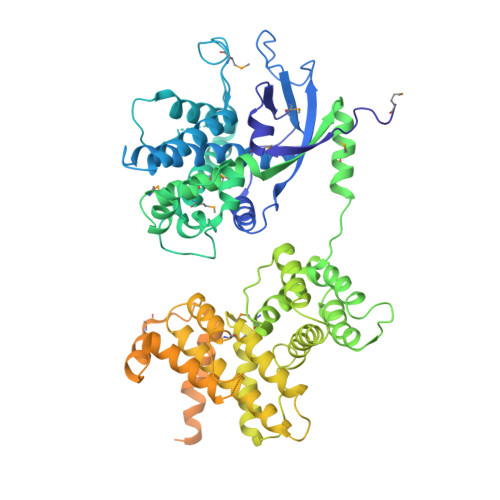SspABCD-SspE is a phosphorothioation-sensing bacterial defence system with broad anti-phage activities.
Xiong, X., Wu, G., Wei, Y., Liu, L., Zhang, Y., Su, R., Jiang, X., Li, M., Gao, H., Tian, X., Zhang, Y., Hu, L., Chen, S., Tang, Y., Jiang, S., Huang, R., Li, Z., Wang, Y., Deng, Z., Wang, J., Dedon, P.C., Chen, S., Wang, L.(2020) Nat Microbiol 5: 917-928
- PubMed: 32251370
- DOI: https://doi.org/10.1038/s41564-020-0700-6
- Primary Citation of Related Structures:
6JIV, 6JUF, 6LB9 - PubMed Abstract:
Bacteria have evolved diverse mechanisms to fend off predation by bacteriophages. We previously identified the Dnd system, which uses DndABCDE to insert sulfur into the DNA backbone as a double-stranded phosphorothioate (PT) modification, and DndFGH, a restriction component. Here, we describe an unusual SspABCD-SspE PT system in Vibrio cyclitrophicus, Escherichia coli and Streptomyces yokosukanensis, which has distinct genetic organization, biochemical functions and phenotypic behaviour. SspABCD confers single-stranded and high-frequency PTs with SspB acting as a nickase and possibly introducing nicks to facilitate sulfur incorporation. Strikingly, SspABCD coupled with SspE provides protection against phages in unusual ways: (1) SspE senses sequence-specific PTs by virtue of its PT-stimulated NTPase activity to exert its anti-phage activity, and (2) SspE inhibits phage propagation by introducing nicking damage to impair phage DNA replication. These results not only expand our knowledge about the diversity and functions of DNA PT modification but also enhance our understanding of the known arsenal of defence systems.
Organizational Affiliation:
Ministry of Education Key Laboratory of Combinatorial Biosynthesis and Drug Discovery, School of Pharmaceutical Sciences, Wuhan University, Wuhan, China.















